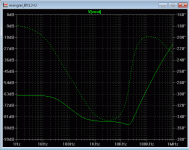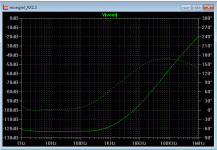I Am debating on the p3A amp or a lm4702 amp.
i built a LM4702 amp with KSA1220A/KSC2690A drivers and 2SC5200/1943 outputs and i think it sounds really good.
some people say it is not that great, it sounds alot better than a TDA7294 amp i have (sharp and tinny).
What do you think about the sound quality of the P3A do you think it sounds better than the LM4702
do you know any other amps that tested/sound better than the P3A/LM4702
i built a LM4702 amp with KSA1220A/KSC2690A drivers and 2SC5200/1943 outputs and i think it sounds really good.
some people say it is not that great, it sounds alot better than a TDA7294 amp i have (sharp and tinny).
What do you think about the sound quality of the P3A do you think it sounds better than the LM4702
do you know any other amps that tested/sound better than the P3A/LM4702
It will be better because it has more power and this will
inevitably have an influence on the perception of the sound..
Other than that, there are very few amps by there that can
be qualified as high definition/high performances, and most
are not worth the effort since it would be better to use
an used 80s japanese amp and refresh it..
inevitably have an influence on the perception of the sound..
Other than that, there are very few amps by there that can
be qualified as high definition/high performances, and most
are not worth the effort since it would be better to use
an used 80s japanese amp and refresh it..
Drivers can be MJE15030/31 -32/33-34/35 or 2sc4793/2sa1837 , better for more load on OP devices. MJE's are good to about 3 pair OP devices (heavy duty).
"Better" is subjective. What is better ? You must build more of them , decide for yourself. Symasym , all of DR. Jagodics (bora's) designs , my AX ... all very good. DX is most simple , no way to "mess up".
OS
"Better" is subjective. What is better ? You must build more of them , decide for yourself. Symasym , all of DR. Jagodics (bora's) designs , my AX ... all very good. DX is most simple , no way to "mess up".
OS
small details for each and every amp mentioned above might cause al ot of diference choise and or combination of semis is one of them ...choise of other parts or choise of bias level
standard versions on standard pcb is something i have no expirience with so i have no opinion ....
as abouts OS's phrase most likely kick the pants off the p3a. i would troully like to see an amp that performs easily 100K square wave with the top corners just rounding up at 100 KHZ to be kicked out by something of the same range and simplicity to built ...
kind regards sakis
standard versions on standard pcb is something i have no expirience with so i have no opinion ....
as abouts OS's phrase most likely kick the pants off the p3a. i would troully like to see an amp that performs easily 100K square wave with the top corners just rounding up at 100 KHZ to be kicked out by something of the same range and simplicity to built ...
kind regards sakis
as abouts OS's phrase most likely kick the pants off the p3a. i would troully like to see an amp that performs easily 100K square wave with the top corners just rounding up at 100 KHZ to be kicked out by something of the same range and simplicity to built ...
There is speed/slew , and there is fidelity(quality). Sometimes there is both , at other times neither.
OS
This time I must agree with Sakis.small details for each and every amp mentioned above might cause al ot of diference choise and or combination of semis is one of them ...choise of other parts or choise of bias level
standard versions on standard pcb is something i have no expirience with so i have no opinion ....
as abouts OS's phrase most likely kick the pants off the p3a. i would troully like to see an amp that performs easily 100K square wave with the top corners just rounding up at 100 KHZ to be kicked out by something of the same range and simplicity to built ...
kind regards sakis
The IC amp outcome is much more well defined, since the parts inside the IC are the result of a very constant industrial process. The P3A (by ESP), on the other end, is a suitable DIY project and the result is very implementation dependent.
If you take care of selecting the right components, match them accuratetely , lay them out properly on the PCB, you will obtain probably a very nice sounding amplifier. On my opinion (I would really like to make the test myself!) it will sound similar to the OS's BX or to the Carlos' DX amp, no offence intended to both our Masters.
You might need a little more tweaking and matching i.e. due to the absence of current mirrors, but that's the fuel for DIY fun.
I have a tweaked TO3-P3A that sounds amazing good, also to the educated ears of my "Audiophile " friends that wan't beliew that there is only a handful of BJT inside . Also there are, on this same forum some other good designs or evolutions that go in that direction (Bootstrap + CFP), the last I believe from our Austrian friend ATAudio, sign that the thing is well alive and kicking in the DIY community.
So, about having fun, no doubt, that's P3A!
it will sound similar to the OS's BX or to the Carlos' DX amp, no offence intended to both our Masters.
I will pass on the chance to be subjective with this. My BX works , but it sucks... I won't comment on the DX.
The IC , or something like my AX/EX (with those "evil" current sources and cap multipliers) , can do 40-70V rails @ under 1mv offset and VAS/IPS current stays within 1/100ma. I had a 4702 and it performs in a similar manner.
Besides the fact that these attributes will assure 20 years MTBF , the question remains (
PS- just had a "refinement" experience , the normal bias spreader sucks ! Add 1- .30c transistor and go from "entry level" to "pro". Sometimes just a couple strategically placed semi's can double the pleasure.
OS
as abouts OS's phrase most likely kick the pants off the p3a. i would troully like to see an amp that performs easily 100K square wave with the top corners just rounding up at 100 KHZ to be kicked out by something of the same range and simplicity to built ...
kind regards sakis
Hi Sakis.
overshoot has a lot to do with phasemargin. The lower the phasemargin the lower the Q.
So you only have to design your amp with the desired phasemargin. But how much will make a simple amp oscillate when subjected to capacitive load?? There all things starts to get complicated.
A perfectly stable amp into a resistive load can oscillate into 47nF load when designed the wrong way.
- Status
- This old topic is closed. If you want to reopen this topic, contact a moderator using the "Report Post" button.
- Home
- Amplifiers
- Solid State
- P3A vs LM4702 AMP's

